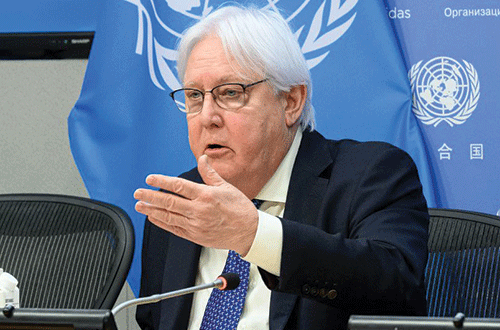GENEVA – The United Nations said yesterday that it needed US$46.4 billion next year to bring life-saving help to around 180 million people in desperate circumstances
around the world.
The UN said the global humanitarian outlook for 2024 was “bleak”, with conflicts, climate emergencies and collapsing economies “wreaking havoc” on the most vulnerable.
While global attention focuses on the conflict raging in the Gaza Strip, the UN said the wider Middle East, Sudan and Afghanistan were among the hotspots which also needed major international aid operations.
However, the size of the annual appeal and the number of people it aims to reach were scaled back compared to 2023, following a decrease in donations.
“Humanitarians are saving lives, fighting hunger, protecting children, pushing back epidemics and providing shelter and sanitation in many of the world’s most inhumane contexts. But the necessary support from the international community is not keeping pace with the needs,” UN aid chief Martin Griffiths said in a statement.
The 2023 appeal was for US$56.7 billion, but received just 35% of that amount, one of the worst funding shortfalls in years. It allowed UN agencies to deliver assistance and protection to 128 million people.
With a few weeks left to go, 2023 is likely to be the first year since 2010 when humanitarian donations declined, compared to the previous year.
The UN, therefore, scaled down its appeal to US$46.4 billion this time around, and will focus on those in the gravest need.
Launching the 2024 Global Humanitarian Overview, Griffiths said the sum was nonetheless a “massive ask” and would be tough to raise, with many donor countries facing their own cost of living crises.
“Without adequate funding, we cannot provide life-saving assistance. And if we cannot provide that assistance, people will pay with their lives,” he added.
The appeal covers aid for 72 countries: 26 states in crisis, and 46 neighbouring nations dealing with the knock-on effects, such as an influx of refugees.
The five largest single-country appeals are for Syria (US$4.4 billion), Ukraine (US$3.1 billion), Afghanistan (US$3 billion), Ethiopia (US$2.9 billion) and Yemen (US$2.8 billion).
Griffiths said there would be 300 million people in need around the world next year, a figure down from 363 million last year.
But the UN aims to reach only 180.5 million of those, with NGOs and aid agencies targeting the remainder, not to mention frontline countries and communities themselves who provide the first help.
The Middle East and North Africa require US$13.9 billion, the largest total for any region in 2024.
Beyond Syria, the Palestinian territories, and Yemen, Griffiths also pointed to Sudan and its neighbours, and Ukraine, Afghanistan, Venezuela and Myanmar as hotspots which needed sustained global attention.
Ukraine is going through a “desperate winter”, with the prospect of more warfare on the other side, he noted.
With the Gaza war between Israel and Hamas, plus Russia’s war in Ukraine, Griffiths said it was hard for the Sudan crisis to get the attention it deserved in foreign capitals.
More broadly, Griffiths observed that climate change would increasingly impact the work of humanitarian aid workers, who would have to learn how to better use climate data to focus aid resources.
“There is no doubt about the climate confronting and competing with conflict as the driver of need. Climate displaces more children now than conflict. It was never thus before,” he emphasised.
-Nampa/AFP


